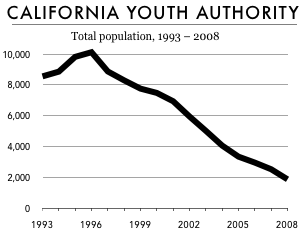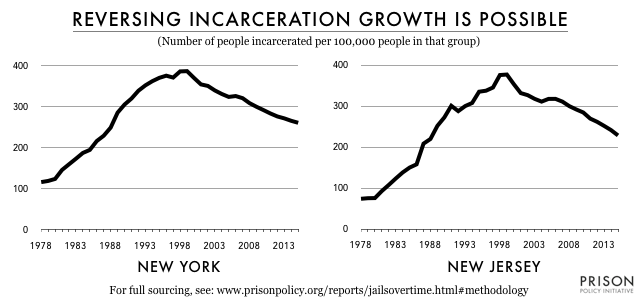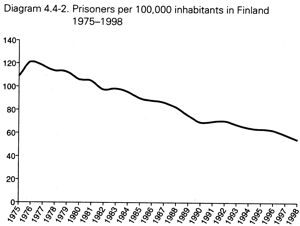Large scale releases and public safety
Can governments safely release hundreds or thousands of people from prison? We offer 14 historical examples to show that, in fact, they already have.
by Peter Wagner, April 9, 2020
To protect the American public from COVID-19, schools have closed, non-essential stores have been shuttered, people with desk jobs have started working from home, and public gatherings have been prohibited. But the prison system continues to hum along as though nothing has changed: Prisons have done virtually nothing to reduce the population density that puts both incarcerated people and staff at grave risk.
To justify their lack of action, criminal justice officials and elected leaders imply that saving the lives of people behind bars is not worth the inevitable public safety cost of releasing them. This talking point is as old as time. It’s also out of step with history.
Large-scale releases have been common throughout U.S. and international history for a variety of legal, political and health reasons. Below is a partial and non-exhaustive summary of some notable examples in U.S. and international history. (These examples were originally collected for a different project with Leah Sakala in 2014.)
If the places where these releases took place became hotbeds of crime, we’d know about it already. But they didn’t. In fact, in many cases, the inverse happened — and the academic literature about these experiences prove it.
SELECTED HISTORICAL DECARCERATION EXAMPLES
U.S. examples
California (adults, 1968 – 1972)
Between 1968 and 1972, while Ronald Reagan was the tough-on-crime Governor of California, the state’s incarceration rate dropped from 146 to 96 per 100,000. The historical record suggests that the decrease was largely due to a state program to incentivize local probation departments to decrease commitments to state facilities, as well as an increased use of parole.
California (youth, 1996 – 2009)
Although California is currently struggling politically with reducing its adult population, that state is a national leader on reducing its incarceration of kids. Previously, the Youth Authority was a “catch-all” for even the lowest-level offenders. Among other reforms, the state has created financial disincentives for counties to send kids to the state system while rewarding them if they kept the kids in local programs.

Compiled from the California Department of Corrections & Rehabilitation report, A Comparison of the Division of Juvenile Justice’s Facility and Parole Populations, released by the Division of Juvenile Justice annually from 1993-2008.
California (currently)
Beginning in 2006 and accelerating in 2009, the California prison population has been dropping. Spurred in part by the Supreme Court’s order in Plata, major changes are underway (although far less than most of us hoped and far less than most of our opponents feared.) Some of the drop in the prison population is the illusory result of “Realignment,” a legislative change that sends people who would previously have gone to state prison to local jails. The California prison population drop is still notable because the state’s prison population is dropping faster than the jail population is increasing, but the actual decline in the number of people incarcerated in California is not as large or as quick as the Supreme Court ordered.
Florida (1963 – 1965)
On the heels of the Supreme Court’s Gideon v. Wainwright decision, Florida had to give thousands of incarcerated people new trials, this time with court-appointed lawyers. For some people, the evidence was too flimsy or dated to withstand a proper legal defense, so over 1,000 people were released in a very short time period.
Illinois (1980 – 1983)
Concerned that the 1978 legislative switch to “determinate” sentencing would lead to prison overcrowding, the Department of Corrections instituted a special program of the parole board awarding extra good time credits. In sum, over 21,000 people, or 60% of all prison releases, were released an average of 105 days early.
Massachusetts (youth, 1969)
Massachusetts, under Republican Governor Frank Sargent and newly-appointed Department of Youth Services Commissioner Jerome Miller, closed its training schools for kids and decarcerated nearly 900 children. The state paroled some children directly home while a new system of community-based alternative programs were developed.
New York & New Jersey (~1999 – present)
A mix of reforms — including policing, sentencing reform and parole — have allowed these two states to radically reduce both the number of people entering prison and how long they are incarcerated. Governors of both parties implemented these reforms at a time when the prison population was still rising nationally. In fact, much of the national prison drop in recent years is the result of these two states plus California.

Washington State (1979-1984)
Over 1,600 people were released early in six different periods over the course of five years.
International examples
Czech Republic (2013)
Outgoing President Václav Klaus gave a mass amnesty/pardon to over 6,000 people, approximately one third of the incarcerated population, as a way to both respond to an overcrowding crisis and to mark the anniversary of Czech Independence. “The president pardoned all convicts with prison terms under one year. The amnesty… also includes people sentenced for non-violent crimes to up to two years in jail, and seniors aged at least 70 whose prison terms do not exceed three years and those aged at least 75 with terms of up to 10 years.”
Finland (1976 – present)
Finland used to have one of the highest incarceration rates in Europe. Finland made a long series of policy changes — including decreasing sentence lengths — to radically lower their use of the prison, and that country now has one of the lowest incarceration rates in the entire world.

Israel (1967)
The Israeli Knesset passed an Amnesty Law that released 501 incarcerated people and closed 15,376 criminal investigations.
Italy (2006 and 1990)
In 2006, to respond to prison overcrowding, the Italian government released 22,000 people, generally those serving three years or less, except for those convicted of Mafia-related crimes, terrorism, sexual violence or usury. An earlier mass pardon in 1990 released 8,451 people out of the total incarcerated population of 26,000.
Russia (numerous, late 1990s through present)
Russia has repeatedly issued large-scale amnesties, used both to manage the populations and to celebrate key events like the 20th anniversary of the constitution. Some amnesties also applied to people with pending charges. One notable and major large-scale amnesty was in 1999, when incarcerated people were released to help control a tuberculosis epidemic that was incubating in the prisons and then spreading to the rest of the country.



